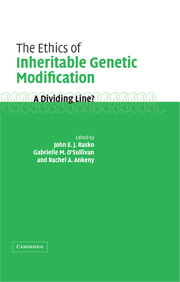Book contents
- Frontmatter
- Contents
- List of contributors
- Foreword: shopping at the genetic supermarket
- List of abbreviations
- Acknowledgments
- 1 Is inheritable genetic modification the new dividing line?
- 2 The science of inheritable genetic modification
- 3 Nuclear cloning, embryonic stem cells, and gene transfer
- 4 Controlling bodies and creating monsters: popular perceptions of genetic modifications
- 5 Inheritable genetic modification as moral responsibility in a creative universe
- 6 Ethics and welfare issues in animal genetic modification
- 7 Radical rupture: exploring biologic sequelae of volitional inheritable genetic modification
- 8 “Alter-ing” the human species? Misplaced essentialism in science policy
- 9 Traditional and feminist bioethical perspectives on gene transfer: is inheritable genetic modification really the problem?
- 10 Inheritable genetic modification and disability: normality and identity
- 11 Regulating inheritable genetic modification, or policing the fertile scientific imagination? A feminist legal response
- 12 Inheritable genetic modification: clinical applications and genetic counseling considerations
- 13 Can bioethics speak to politics about the prospect of inheritable genetic modification? If so, what might it say?
- Glossary of scientific terms
- Index
7 - Radical rupture: exploring biologic sequelae of volitional inheritable genetic modification
Published online by Cambridge University Press: 29 January 2010
- Frontmatter
- Contents
- List of contributors
- Foreword: shopping at the genetic supermarket
- List of abbreviations
- Acknowledgments
- 1 Is inheritable genetic modification the new dividing line?
- 2 The science of inheritable genetic modification
- 3 Nuclear cloning, embryonic stem cells, and gene transfer
- 4 Controlling bodies and creating monsters: popular perceptions of genetic modifications
- 5 Inheritable genetic modification as moral responsibility in a creative universe
- 6 Ethics and welfare issues in animal genetic modification
- 7 Radical rupture: exploring biologic sequelae of volitional inheritable genetic modification
- 8 “Alter-ing” the human species? Misplaced essentialism in science policy
- 9 Traditional and feminist bioethical perspectives on gene transfer: is inheritable genetic modification really the problem?
- 10 Inheritable genetic modification and disability: normality and identity
- 11 Regulating inheritable genetic modification, or policing the fertile scientific imagination? A feminist legal response
- 12 Inheritable genetic modification: clinical applications and genetic counseling considerations
- 13 Can bioethics speak to politics about the prospect of inheritable genetic modification? If so, what might it say?
- Glossary of scientific terms
- Index
Summary
Introduction
In the late 1960s and early 1970s, there was considerable debate about the ethics of research involving the genetic modification of humans by inserting, repairing, or deleting genes. Opponents of gene transfer research argued that genetic interventions were dangerously different from other therapeutic interventions, while the proponents of such research insisted that somatic cell gene transfer (SCGT) was simply a logical extension of available techniques for treating disease. Those advocating gene transfer research argued, convincingly, that products of genetically modified somatic cells are similar to medications currently available (e.g., enzyme therapies for adenosine deaminase [ADA] deficiency) and that the techniques involved are similar to other widely used medical interventions (e.g., transplantation of tissues). At the time, much ado was made about the fact that the proposed genetic modifications would affect only non-reproductive cells. Out of this debate emerged a moral demarcation line between SCGT and germ-line gene transfer (GLGT); under certain constraints and with appropriate oversight, it would be ethically acceptable to proceed with SCGT research, provided the proposed interventions would not affect the germ cells. The science moved forward on these terms; the ethical debate was, for some time, relatively quiescent.
In the late 1980s and early 1990s, however, with the move to clinical trials involving SCGT, debate about the ethics of gene transfer experiments resurfaced. Many began to question the entrenchment of the moral demarcation line between SCGT and inheritable genetic modification (IGM) and, in particular, to emphasize the potential benefits of research on IGM, especially GLGT.
Information
- Type
- Chapter
- Information
- The Ethics of Inheritable Genetic ModificationA Dividing Line?, pp. 131 - 148Publisher: Cambridge University PressPrint publication year: 2006
Accessibility standard: Unknown
- 2
- Cited by
